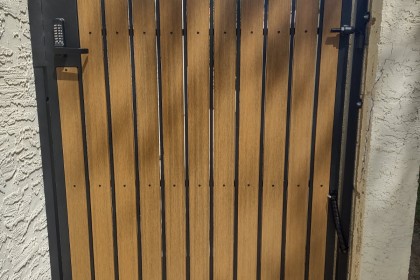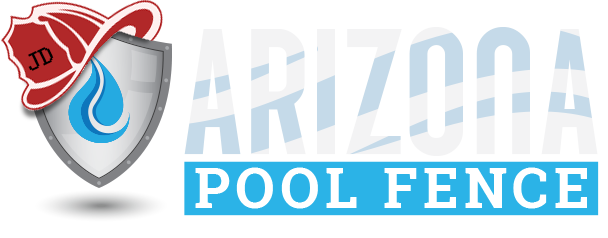Extra Protective Features Every Pool Owner Should Consider

Safety around water should never be taken lightly in Arizona, where backyard pools are as abundant as the sun. Although a safe pool fence is a terrific place to start, many families realize that it’s insufficient on its own because of the year-round swimming weather and frequent get-togethers. Because of this, prudent homeowners throughout the valley are increasingly incorporating extra pool safety features.
Whether you reside in Phoenix, Scottsdale, Mesa, or somewhere in between, a multi-layered safety strategy is necessary to safeguard your loved ones, visitors, and even pets. Every extra precaution, from safety netting and self-latching doors to self-closing gates and lockable side yard access, lowers risk and offers comfort.
Why Pool Safety Should Go Beyond the Fence
Safety is an ongoing fear in Arizona, where swimming pools are essential to outdoor life, particularly for households with small children or pets. Drowning is one of the most common unintentional causes of death for children under five in Arizona, according to the state’s Department of Health Services. The fact that many of these incidents occur in backyard pools with existing barriers is even more concerning.
For this reason, as stipulated by Arizona law and safety experts, layers of protection are crucial for pool safety. Although a fence provides a physical barrier, it is not infallible. Due to their innate curiosity, children can easily climb over badly maintained areas, slide under open gates, or approach the pool area through an unguarded patio door or side yard.
Additional pool safety measures like safety netting, secured side yard gates, door alarms, and self-closing gates help fill in the holes that a typical fence cannot. Together, these layers considerably lower the chance of unauthorized access, whether you’re at home or away.
These extra safety precautions provide homeowners in the Phoenix Valley, from Gilbert to Glendale, something invaluable: peace of mind. Knowing your pool is safe on all sides lets you enjoy it more without worrying about what might happen when you’re not looking.
Side Yard Gates with Locks
Most Arizona homeowners prioritize the backyard fence when it comes to pool safety, yet side yard gates are among the most frequently disregarded entry points. These gates, which frequently go straight to the pool area, may inadvertently be left unlocked, particularly if they are utilized as shortcuts between yards, for garbage cans, or for maintenance access. Side gates can become a serious weakness in your pool’s safety plan if they are not properly locked.
Protecting all points of entrance, not just the main gate, is necessary to secure your pool area properly. This category includes side yard gates, which may not even be visible from inside your house. Installing trustworthy locks is one simple yet effective method to ensure these less visible passageways don’t become safety problems.
There are several lock options to consider:
- Keyed locks offer strong security but can be inconvenient if keys are misplaced.
- Combination locks eliminate the need for a key but require the code to be memorized (or hidden nearby, which can reduce safety).
- Magnetic gate locks are tamper-resistant and durable, making them a fantastic long-term choice for metal or wrought iron gates.
Keypad or smart locks are the best option for busy Arizona homes, particularly those with children or regular visitors. These let you remotely manage access, set unique codes for family members, and get notifications when the gate is opened. For side gates that aren’t always visible from the house, they are really helpful.
Beyond simply closing the gate, you should childproof it if your yard is sloping or your fence is old. To keep hardware out of reach, such measures can entail installing a lockbox, adding reinforcement bars, or increasing the latch height. Per local safety requirements, numerous pool safety experts in Arizona advise a minimum latch height of 54 inches.
By taking the time to secure your side yard gates properly, you can be sure that there are other barriers between your loved ones and possible danger besides your pool fence. It’s a simple enhancement that offers comfort, especially in an area where people use swimming pools nearly year-round.
Self-Closing and Self-Latching Gates
Self-closing and self-latching gate systems are useful since a fence is only as robust as its gate. By ensuring that your gate automatically closes and latches each time it is opened, these devices reduce the possibility that someone will forget to close it after themselves.
When the gate is released, self-closing hinges use hydraulic or spring tension to draw it shut. When closed, a self-latching mechanism automatically locks it into position. Human error is a crucial component of pool safety, particularly in houses with kids, visitors, or heavy foot traffic. This automatic re-securing eliminates human mistakes from the equation.
The majority of communities in Arizona, where pool safety laws are taken seriously, mandate that gates have self-closing and self-latching features as part of their pool barrier ordinance. These gates must latch and close from any open position; they shouldn’t need any help or force to latch correctly. In addition to lowering liability, these items are frequently mandated by law, especially for households with children under six.
For maximum effectiveness, installers recommend:
- Mounting the latch at least 54 inches above ground level to keep it out of reach of small children
- Adjusting the hinge tension so that the gate closes firmly without slamming
- Regularly checking for alignment and smooth operation, especially in Arizona’s extreme heat, which can affect materials over time
Although most people concentrate on putting self-closing and self-latching gates at the pool’s main entry, side yard gates and any other secondary entrances should also have these features installed. The same automatic safeguards ought to be in place anywhere someone can enter the pool.
These gate modifications, which operate around the clock without the need for checklists or reminders, provide your pool setup a passive yet effective layer of security, whether you’re in Phoenix, Chandler, or Peoria.
Pool Safety Nets
The pool safety net, a straightforward yet incredibly effective barrier that physically keeps someone from falling into the water, is another potent addition to any pool safety system. These nets form a sturdy, safe web that can sustain a child’s or pet’s weight since they are specially made to fit the contour of your pool and are fastened firmly over the surface using tensioning methods.
Safety nets are lightweight, detachable, and portable, which makes them perfect for families who frequently use their pool but still wish to guard against unauthorized access. This is in contrast to large pool coverings. When built correctly, the net completely encloses the pool’s surface, forming a physical barrier that prevents anyone from slipping through, regardless of how inquisitive or determined they may be.
In Arizona, pool safety nets are particularly popular for houses with large or irregularly shaped pools, where conventional hardcovers or alarms might not be sufficient. The net can provide seamless protection even for freeform or multi-level pool designs because it can adapt to any shape. It is among the most adaptable additional pool safety features available due to its versatility.
Safety nets prevent access altogether, which is a critical distinction when preventing catastrophe, whereas pool alarms notify you once someone enters the water. Additionally, nets are quick to unclip and roll away when you’re ready to swim, in contrast to safety covers, which may be costly, heavy, and time-consuming to remove.
To function properly, pool safety nets must be:
- Professionally measured and installed to ensure a tight fit with no slack
- Tensioned correctly with anchors and pulleys, so they can’t be easily pulled up or removed by a child
- Inspected regularly, especially in Arizona’s heat, which can affect the net’s elasticity over time
A safety net is an intelligent, efficient, and low-maintenance layer of protection that complements your fence, gates, and latches if you’re serious about pool safety, especially in high-use or high-risk homes.
Self-Closing Doors to the Pool Area
The pool is frequently located right next to the kitchen or living room in Arizona homes, particularly those with open floor plans or huge glass sliding doors. This location makes the transition from interior to outdoor space smooth, but it also poses a significant safety risk, especially for families with small children or visitors who might not be comfortable with the arrangement.
Like any other pool access point, doors that lead straight from the house to the pool must be handled carefully. If safety measures are not taken, a single unsecured or propped-open door could allow an unattended child to enter the pool area undetected.
Installing self-closing door hinges or automatic door-closing devices is a highly suggested solution to this problem, and local construction rules frequently mandate it. Even if someone forgets to close the door, these mechanisms ensure it automatically returns to its closed position. They work especially well on side doors that open directly to patios or backyards, French doors, and sliders.
Installing and programming door alarms to sound an alert whenever a pool-access door is opened would increase security. Many systems allow for:
- Loud audible alerts to notify adults in the home immediately
- Customizable time delays (e.g., a 7-second delay before sounding if the door isn’t closed again)
- Bypass features for adults to use without triggering the alarm
Some modern home security systems in Arizona can even integrate these alarms with smart home devices, sending alerts directly to your phone or triggering connected cameras to record.
When installing self-closing mechanisms and alarms, be sure to follow Arizona pool safety codes, which typically require:
- Sound alerts of at least 85 decibels when the door is opened
- Mounting the alarm control switch at least 54 inches above the floor
- Automatically resetting alarms after use, so they’re always active
Incorporating these features into your home setup ensures that your pool area is secure from both outside and inside access points, creating a full-circle approach to safety that protects everyone under your roof.
The Importance of Routine Safety Checks and Maintenance
Installing extra pool safety features is only the beginning—keeping them functional is just as important. Over time, even the best equipment can wear down, especially in Arizona’s extreme climate. That’s why regular maintenance should be part of your pool safety routine.
Start with a weekly or monthly checklist that includes:
- Testing all gates and latches to make sure they close and latch on their own
- Checking side yard gate locks for signs of rust or sticking
- Inspecting safety nets for any slack, fraying, or improper tension
- Verifying that door alarms and self-closing devices are working properly
- Making sure smart locks or electronic devices have fresh batteries or are charging as expected
In Arizona, materials may suffer from the harsh sun, high temperatures, and seasonal monsoons. Particularly after months of exposure to intense sunlight, rubber or vinyl may crack or deteriorate, metal parts may rust, and plastic components may deform. Because of this, proactive replacement and regular inspection are required, not optional.
Don’t put off repairs if a hinge squeaks, a latch feels loose, or a net appears to be sagging. In a matter of seconds, minor problems can become hazardous mistakes. Many pool safety experts advise conducting a thorough review of all your protective measures at the beginning and end of every swimming season and, more often, during busy times like summer vacations.
You can help guarantee that your layers of protection remain robust, providing you with long-term peace of mind and lowering the chance of expensive or fatal incidents, by setting aside a few minutes each week to check and maintain your safety features.
Educating the Household: A Key Layer of Safety
Nothing can replace education and awareness, even with the best pool safety features in place. Ensuring everyone in your house, including children, adults, and guests, knows how to stay safe around the pool is one of the strongest defenses.
Begin by educating children about pool safety at a young age. They should be aware that gates and netting are not toys and that the pool is off-limits to children without adult supervision. Strong habits can be formed early on with the help of simple rules like “no swimming without asking” or “stay away from the fence unless an adult is with you.” With pools available all year round, swim lessons are yet another excellent investment for families in Arizona.
Establishing explicit pool regulations for visitors, babysitters, and visiting family members is also crucial. Everyone must agree, whether you’re throwing a backyard barbecue in Scottsdale or hiring a sitter for the kids in Mesa. If your safety measures include smart locks, alarms, or detachable netting that needs a brief training, write down the instructions and put them up by the pool.
Most importantly, adult supervision cannot be compromised. Regardless of the sophistication of the safety equipment, it cannot replace the role of an adult monitoring the water. Drownings frequently occur quickly and silently. The best defense is still an attentive adult, even with levels of security like pool alarms and self-closing gates.
Providing pool safety education to all members of your home guarantees that wise choices and open communication support your physical barriers. These components work together to make your Arizona backyard haven safer for all visitors.
Combine Layers for Real Protection
There isn’t one answer for keeping your pool area safe; it requires a mix of awareness, habits, and tools. A pool fence is the foundation, but a multi-layered defense that drastically lowers danger is achieved by including side yard gates with locks, self-closing and self-latching gates, pool safety nets, and self-closing doors. Every element contributes to ensuring that a single failure endangers your loved ones.
Working smarter, not harder, is the key to proper pool safety, which entails combining the appropriate tools with astute routines, constant upkeep, and family awareness. Creating a location where your family, friends, and pets can feel safe and secure throughout the year is more important than simply adhering to the code.
We can assist you in improving the safety of your pool if you live in Arizona. Our staff can provide expertly installed solutions customized for your property, whether you’re installing your first safety net or want to upgrade all of your gate hardware.
For a free pool safety assessment or consultation, contact us now. More layers of protection equal more peace of mind.























































